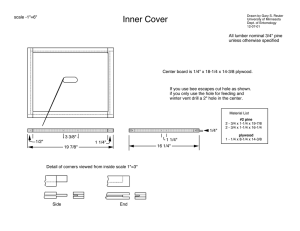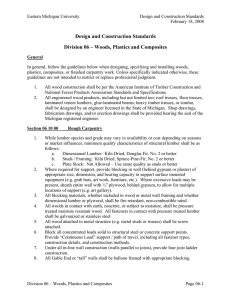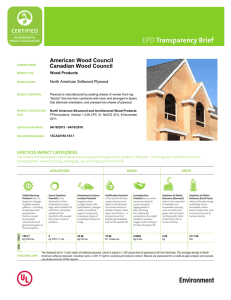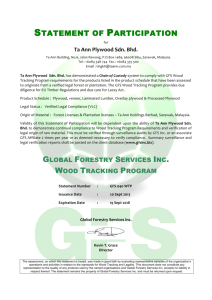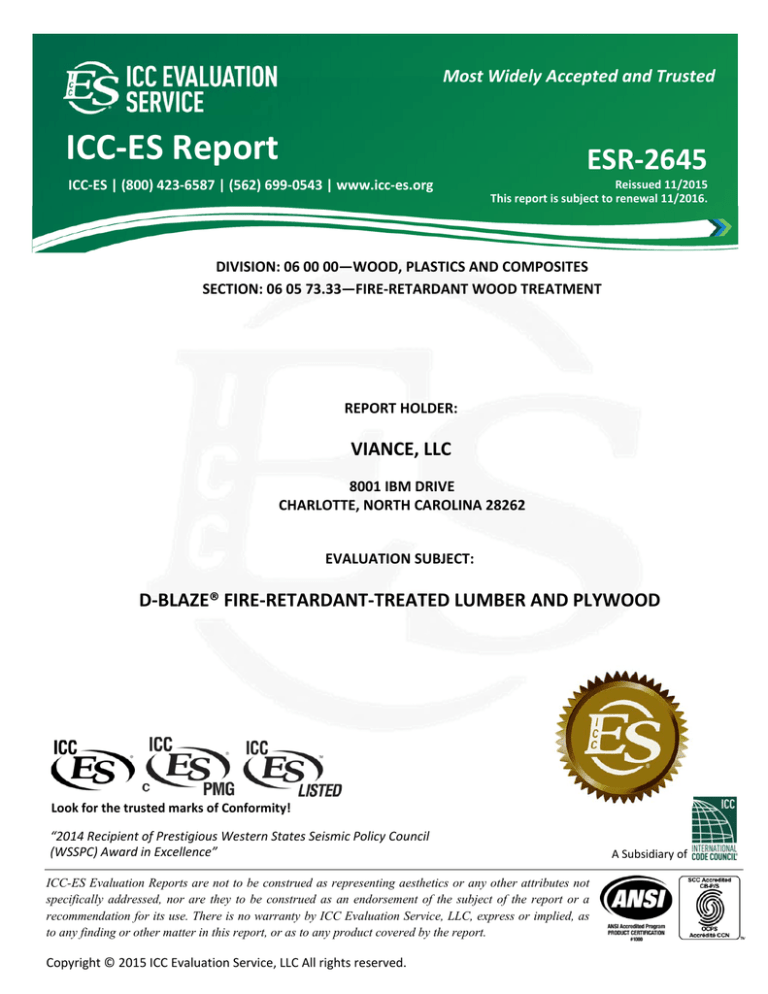
Most Widely Accepted and Trusted 0 ICC‐ES Report ESR‐2645
ICC‐ES | (800) 423‐6587 | (562) 699‐0543 | www.icc‐es.org
000 Reissued 11/2015
This report is subject to renewal 11/2016.
DIVISION: 06 00 00—WOOD, PLASTICS AND COMPOSITES SECTION: 06 05 73.33—FIRE‐RETARDANT WOOD TREATMENT REPORT HOLDER: VIANCE, LLC 8001 IBM DRIVE CHARLOTTE, NORTH CAROLINA 28262 EVALUATION SUBJECT: D‐BLAZE® FIRE‐RETARDANT‐TREATED LUMBER AND PLYWOOD Look for the trusted marks of Conformity! “2014 Recipient of Prestigious Western States Seismic Policy Council (WSSPC) Award in Excellence” ICC-ES Evaluation Reports are not to be construed as representing aesthetics or any other attributes not
specifically addressed, nor are they to be construed as an endorsement of the subject of the report or a
recommendation for its use. There is no warranty by ICC Evaluation Service, LLC, express or implied, as
to any finding or other matter in this report, or as to any product covered by the report.
Copyright © 2015 ICC Evaluation Service, LLC All rights reserved.
A Subsidiary of ICC-ES Evaluation Report
ESR-2645
Reissued November 2015
This report is subject to renewal November 2016.
www.icc-es.org | (800) 423-6587 | (562) 699-0543
DIVISION: 06 00 00—WOOD, PLASTICS, AND
COMPOSITES
Section: 06 05 73.33—Fire-Retardant Wood Treatment
A Subsidiary of the International Code Council ®
that may be exposed to dampness where the code permits
the use of wood or fire-retardant-treated wood.
3.0 DESCRIPTION
3.1 General:
REPORT HOLDER:
D-Blaze® interior fire-retardant-treated wood is lumber and
plywood that is pressure-impregnated with D-Blaze® fireretardant chemicals.
VIANCE, LLC
8001 IBM DRIVE
CHARLOTTE, NORTH CAROLINA 28262
(704) 522-0825
www.viance.net
D-Blaze treatment of lumber of the following species is
recognized as being fire-retardant:
EVALUATION SUBJECT:
Southern pine
Engelmann spruce
Ponderosa pine
White spruce
®
D-BLAZE FIRE-RETARDANT-TREATED LUMBER AND
PLYWOOD
Douglas fir
Alpine fir
Western hemlock
Balsam fir
ADDITIONAL LISTEES:
Red pine
Lodgepole pine
FONTANA WOOD PRESERVING
15500 VALENCIA AVENUE
POST OFFICE BOX 1070
FONTANA, CALIFORNIA 92334-1070
White fir
Hem-fir
Basswood
Jack pine
THUNDERBOLT WOOD TREATING
3400 PATTERSON ROAD
RIVERBANK, CALIFORNIA 95367
Red oak
Red spruce
Spruce-pine-fir
Black spruce
D-Blaze® treatment of plywood fabricated with face and
back veneers of the following species is recognized as
being fire-retardant:
TRUEGUARD LLC
715 DENVER AVENUE
LOVELAND, COLORADO 80537
Southern pine
Douglas fir
Lauan
Red pine
3.2 Flame Spread:
1.0 EVALUATION SCOPE
Compliance with the following codes:
2012, 2009, and 2006 International Building Code
(IBC)
®
2012, 2009, and 2006 International Residential Code
(IRC)
®
Properties evaluated:
Flame spread
Structural
Corrosion
Hygroscopicity
2.0 USES
®
D-Blaze fire-retardant-treated wood is used in interior
areas that are not exposed to the weather or wetting, but
D-Blaze® fire-retardant-treated wood has a flame-spread
index of 25 or less when subjected to ASTM E84 tests of
30 minutes duration without evidence of significant
progressive combustion.
3.3 Structural Strength and Durability:
®
3.3.1 General: The effects of the D-Blaze fire-retardant
treatment on the strength of the treated lumber and
plywood must be accounted for in the design of the wood
members and their connections. Load duration factors
greater than 1.6 are not permitted to be used in the design.
3.3.2 Lumber: The design properties of lumber, when
treated with D-Blaze® fire-retardant chemicals and used in
applications at ambient temperatures up to 150°F (66°C),
must be subject to the adjustment factors shown in Table
1.
3.3.3 Plywood: The design properties of plywood, when
treated with D-Blaze® fire-retardant chemicals and used in
ICC-ES Evaluation Reports are not to be construed as representing aesthetics or any other attributes not specifically addressed, nor are they to be construed
as an endorsement of the subject of the report or a recommendation for its use. There is no warranty by ICC Evaluation Service, LLC, express or implied, as
to any finding or other matter in this report, or as to any product covered by the report.
1000
Copyright © 2015 ICC Evaluation Service, LLC. All rights reserved.
Page 1 of 5
ESR-2645 | Most Widely Accepted and Trusted
applications at temperatures up to 170°F (76.5°C), must be
subject to the span limitations shown in Tables 2 and 3.
3.4 Corrosion:
The corrosion rate of aluminum (2024-T3), carbon steel
(SAE 1010), or galvanized steel in contact with wood is not
increased by D-Blaze® fire-retardant treatment when the
product is used as recommended by the manufacturer.
3.5 Hygroscopicity:
D-Blaze® treated wood qualifies as an Interior Type A (HT)
fire-retardant wood in accordance with the American
Wood-Protection Association (AWPA) Standard U1,
Commodity Specification H, Use Category UCFA.
4.0 DESIGN AND INSTALLATION
4.1 General:
Page 2 of 5
5.0 CONDITIONS OF USE
®
The D-Blaze Fire-Retardant-Treated Wood described in
this report complies with, or is a suitable alternative to what
is specified in, those codes listed in Section 1.0 of this
report, subject to the following conditions:
5.1 Structural calculations must be subject to the
adjustment factors or span ratings shown in Tables 1,
2, 3 and 4.
5.2 The adjustment factors and span ratings given in this
report must only be used for unincised dimension
lumber and plywood of the species noted in this
report.
5.3 D-Blaze® treated wood must not be installed where it
will be exposed to precipitation, direct wetting or
regular condensation.
Structural systems that include D-Blaze® fire-retardanttreated lumber or plywood must be designed and installed
in accordance with the applicable code using the
appropriate adjustment factors for lumber from Table 1 and
spans for plywood from Tables 2, 3 and 4 of this report.
Ventilation must be provided in accordance with the
applicable codes.
5.4 D-Blaze® treated wood must not be used in contact
with the ground.
The adjustment factors for lumber and plywood spans in
Tables 1, 2, 3 and 4 of this report are applicable under
elevated temperatures resulting from cyclic climatic
conditions. They are not applicable under continuous
elevated temperatures resulting from manufacturing or
other processes that require special consideration in
design.
5.6 Treatment is at the facilities of the listees noted in this
report, under a quality control program with
inspections by ICC-ES and UL LLC (AA-668) (limited
to “FR-2” classifications) and either Timber Products
Inspection Inc. (AA-696 and AA-664) or Southern
Pine Inspection Bureau, Inc. (AA-680).
The treated lumber and plywood must only be used in
areas (including attic spaces) where the lumber is exposed
to temperatures of 150°F (66°C) or less and the plywood is
exposed to temperatures of 170°F (76.5°C) or less.
Exposure to precipitation during storage or installation
must be avoided. If material does become wet, it must be
replaced or permitted to dry (maximum 19 percent
moisture content for lumber and 15 percent moisture
content for plywood) prior to covering or enclosure by
wallboard or other construction materials (except for
protection during construction).
4.2 Fasteners:
®
Fasteners used in D-Blaze fire-retardant-treated wood
must be galvanized steel, stainless steel, silicon bronze or
copper, in accordance with 2012, 2009, and 2006 IBC
Section 2304.9.5, 2012 and 2009 IRC Section R317.3 or
2006 IRC Section R319.3 and are subject to the
adjustment factors of Table 1.
®
5.5 D-Blaze lumber must not be ripped or milled as this
will alter the surface-burning characteristics and
invalidate the flame-spread classification. Framing,
end cuts, holes, joints such as tongue and groove,
bevel, scarf and lap may be used.
6.0 EVIDENCE SUBMITTED
Data in accordance with the ICC-ES Acceptance Criteria
for Fire-retardant-treated Wood (AC66), dated June 2012
(editorially revised February 2014).
7.0 IDENTIFICATION
Lumber and plywood treated with D-Blaze® fire-retardant
chemicals must be identified by the structural grade mark
of an approved agency. In addition, all treated lumber and
plywood must be stamped with the name of the inspection
agency (AA-668) (limited to “FR-2” classifications) and
either Timber Products Inspection Inc. (AA-696 and 664) or
Southern Pine Inspection Bureau, Inc. (AA-680)]; the
Viance, LLC, or listee, name and address; the production
plant identification (refer to Table 5 for treatment locations);
labeling information in accordance with Section 2303.2.4 of
the 2012 and 2009 IBC and Section 2303.2.1 of the 2006
IBC; and the evaluation report number (ESR-2645). Refer
to Figure 1.
ESR-2645 | Most Widely Accepted and Trusted
Page 3 of 5
TABLE 1―DESIGN VALUE ADJUSTMENT FACTORS
®
FOR D-BLAZE FIRE-RETARDANT LUMBER COMPARED TO UNTREATED LUMBER
PROPERTY
®
D-BLAZE LUMBER
1,2
ROOF FRAMING, CLIMATE ZONE
SERVICE
TEMPERATURE
< 100°F (38°C)
1A
1B
2
0.935
0.935
0.935
0.935
Horizontal Shear
0.985
0.838
0.894
0.964
Tension Parallel
0.874
0.625
0.775
0.905
Bending: Modulus of Elasticity, E
1.000
0.977
0.986
0.997
Bending: Extreme Fiber Stress, Fb
0.972
0.740
0.828
0.939
Fasteners/Connectors
0.900
0.900
0.900
0.900
Compression Parallel, Fc
1
Climate Zone definition:
Zone 1 – Minimum design roof live load or maximum ground snow load ≤ 20 psf (960 Pa)
Zone 1A – Southwest Arizona, southeast Nevada (area Bounded by Las Vegas- Yuma- Phoenix- Tucson)
Zone 1B – All other qualifying areas of the United States
Zone 2 – Maximum ground snow load > 20 psf (960 Pa).
2
Duration of load adjustments for snow loads, 7-day (construction) loads, and wind loads as given in the National Design Specification for
®
Wood Construction (NDS) also apply.
®
TABLE 2―SPAN RATINGS FOR D-BLAZE FIRE-RETARDANT SOUTHERN PINE PLYWOOD FOR ROOF SHEATHING
APPLICABLE AT A TEMPERATURE UP TO170°F (77°C) BASED ON UNIFORM LOADING,
TWO-SPAN CONSTRUCTION AND L/180 DEFLECTION LIMIT
® 1,2,3,4,5,8,9,10,11
D-BLAZE
PLYWOOD ROOF SHEATHING SPAN RATINGS
USED AT TEMPERATURES > 100°F (38°C) AND <170°F (77°C)
PLYWOOD
THICKNESS
(inches)
CLIMATE ZONE
6,7
ZONE 1A
ZONE 1B
3
0.375
20
20
20
15
0.469
24
24
24
1
0.500
24
24
24
19
0.594
32
32
32
/8
/32
/2
/32
ZONE 2
5
0.625
32
32
32
23
0.719
40
32
40
3
0.750
40
32
40
7
/8
0.875
40
40
48
1
1.000
48
48
48
1
1.125
48
48
48
/8
/32
/4
1 /8
2
SI Units Conversion: 1 inch = 25.4 mm, 1 psf = 48 N/m .
1
All Span ratings are based on two-span condition with panels 24 inches wide or wider, strength axis perpendicular to supports.
Fastener size and spacing must be as required in the applicable building code for untreated plywood of the same thickness.
Roof spans and loads apply to roof systems having the minimum ventilation areas required by the applicable building code. Fifty percent of
required vent area must be located on upper portion of sloped roofs to provide natural air flow.
4
For low-sloped or flat roofs with membrane or built-up roofing having a perm rating less than 0.2, use rigid insulation having a minimum
19
23
R value of 4.0 between sheathing and roofing, or use next thicker panel than tabulated for the span and load (e.g., /32 for 24 inches, /32 for
32 inches); and use a continuous ceiling air barrier and vapor retarder with a perm rating less than 0.2 on the bottom of the roof framing above
the ceiling finish.
5
For unblocked roof diaphragms panel edge clips are required for roof sheathing: one midway between supports for 24-inch and 32-inch
1
spans, two at /3 points between supports for 48-inch span. Clips must be specifically manufactured for the plywood thickness used.
6
Tabulated loads for Zone 1A are based on 20 psf roof live load with a duration of load adjustment for 7-day (construction) loads of 1.25.
Tabulated loads for Zone 1B and Zone 2 are based on 30 psf snow load with a duration of load adjustment for snow of 1.15. All values within
the table are based on a dead load (DL) of 8 psf. If the DL is less than or greater than 8 psf, the live or snow load may be increased or
1
5
3
decreased by the difference. Applicable material weights, psf: asphalt shingles - 2.0, /2-inch plywood - 1.5, /8-inch plywood - 1.8, /4-inch
plywood - 2.2.
7
Climate Zone definition:
ZONE 1 – Minimum design roof live load or maximum ground snow load ≤ 20 psf (960 Pa)
ZONE 1A – Southwest Arizona, southeast Nevada (area Bounded by Las Vegas- Yuma- Phoenix- Tucson)
ZONE 1B- All other qualifying areas of the United States
ZONE 2 – Maximum ground snow load > 20 psf (960 Pa).
8
D-Blaze treated plywood must not be used as roof sheathing if a radiant shield is used beneath the roof sheathing.
9
19
5
23
3
The /32-inch and /8-inch thickness are limited to performance rated 4-ply or 5-ply. /32- and /4-inch thicknesses are limited to performance
rated 5-ply or 7-ply.
10
1
Deflection of roof sheathing at tabulated maximum live load is less than /240 of the span, and under maximum live load plus dead load is less
1
than /180 of the span.
11
15
Staples used to attach asphalt shingles must be minimum /16-inch crown and minimum 1-inch leg, or otherwise comply with the applicable
code, with the quantity of fasteners adjusted in accordance with Table 1 of this report.
2
3
ESR-2645 | Most Widely Accepted and Trusted
Page 4 of 5
®
TABLE 3―SPAN RATINGS FOR D-BLAZE FIRE-RETARDANT
DOUGLAS FIR AND OTHER SPECIES PLYWOOD FOR ROOF SHEATHING
APPLICABLE AT A TEMPERATURE UP TO 170°F (77°C) BASED ON UNIFORM LOADING,
TWO-SPAN CONSTRUCTION AND L/180 DEFLECTION LIMIT
®1,2,3,4,5,8,9,10,11
D-BLAZE
PLYWOOD ROOF SHEATHING SPAN RATINGS
USED AT TEMPERATURES > 100°F (38°C) AND <170°F (77°C)
PLYWOOD
THICKNESS
(inches)
CLIMATE ZONE
6,7
ZONE 1A
ZONE 1B
3
0.375
16
16
20
15
0.469
20
20
24
/8
/32
ZONE 2
1
0.500
20
20
24
19
0.594
24
24
32
5
/2
/32
0.625
24
24
32
23
/8
0.719
32
32
32
3
0.750
32
32
32
7
/8
0.875
40
32
40
1
1.000
40
40
48
1
1.125
48
40
48
/32
/4
1 /8
2
SI Units Conversion: 1 inch = 25.4 mm, 1 psf = 48 N/m .
1
All Span ratings are based on two-span condition with panels 24 inches wide or wider, strength axis perpendicular to supports.
Fastener size and spacing must be as required in the applicable building code for untreated plywood of the same thickness.
3
Roof spans and loads apply to roof systems having the minimum ventilation areas required by the applicable building code. Fifty percent of
required vent area must be located on upper portion of sloped roofs to provide natural air flow.
4
For low-sloped or flat roofs with membrane or built-up roofing having a perm rating less than 0.2, use rigid insulation having a minimum
19
23
R value of 4.0 between sheathing and roofing, or use next thicker panel than tabulated for the span and load (e.g., /32 for 24 inches, /32 for
32 inches); and use a continuous ceiling air barrier and vapor retarder with a perm rating less than 0.2 on the bottom of the roof framing above
the ceiling finish.
5
For unblocked roof diaphragms panel edge clips are required for roof sheathing: one midway between supports for 24-inch and 32-inch
1
spans, two at /3 points between supports for 48-inch span. Clips must be specifically manufactured for the plywood thickness used.
6
Tabulated loads for Zone 1A are based on 20 psf roof live load with a duration of load adjustment for 7-day (construction) loads of 1.25.
Tabulated loads for Zone 1B and Zone 2 are based on 30 psf snow load with a duration of load adjustment for snow of 1.15. All values within
the table are based on a dead load (DL) of 8 psf. If the DL is less than or greater than 8 psf, the live or snow load may be increased or
1
5
3
decreased by the difference. Applicable material weights, psf: asphalt shingles - 2.0, /2-inch plywood - 1.5, /8-inch plywood - 1.8, /4-inch
plywood - 2.2.
7
Climate Zone definition:
ZONE 1 – Minimum design roof live load or maximum ground snow load ≤ 20 psf (960 Pa)
ZONE 1A – Southwest Arizona, southeast Nevada (area Bounded by Las Vegas- Yuma- Phoenix- Tucson)
ZONE 1B- All other qualifying areas of the United States
ZONE 2 – Maximum ground snow load > 20 psf (960 Pa).
8
D-Blaze treated plywood must not be used as roof sheathing if a radiant shield is used beneath the roof sheathing.
9
19
5
23
3
The /32-inch and /8-inch thickness are limited to performance rated 4-ply or 5-ply. /32- and /4-inch thicknesses are limited to performance
rated 5-ply or 7-ply.
10
1
Deflection of roof sheathing at tabulated maximum live load is less than /240 of the span, and under maximum live load plus dead load is less
1
than /180 of the span.
11
15
Staples used to attach asphalt shingles must be minimum /16-inch crown and minimum 1-inch leg, or otherwise comply with the applicable
code, with the quantity of fasteners adjusted in accordance with Table 1 of this report.
2
®
TABLE 4―D-BLAZE TREATED PLYWOOD SUBFLOOR ALLOWABLE SPANS (inches)
USED AT TEMPERATURES <100°F (38°C)
PLYWOOD
THICKNESS (inches)
SOUTHERN PINE
1,2
ALLOWABLE SPAN (inches)
DOUGLAS FIR
1,2
ALLOWABLE SPAN (inches)
12
3
12
15
16
16
1
16
16
/8
/32
/2
19
19.2
19.2
5
19.2
19.2
23
24
24
3
24
24
24
/32
/8
/32
/4
7
/8
24
1
32
32
1
32
32
1 /8
2
SI Units Conversion: 1 inch = 25.4 mm, 1 psf = 48 N/m .
1
Uniform live load = 100 psf and Dead load = 10 psf, LL deflection ≤ L/360, LL+ DL deflection ≤L/240
Fastener size and spacing must be as required in the applicable building code for untreated plywood of the same thickness.
2
ESR-2645 | Most Widely Accepted and Trusted
Page 5 of 5
TABLE 5―D-BLAZE TREATMENT LOCATIONS
LISTEE
D-BLAZE TREATMENT LOCATION
Fontana Wood Preserving
Fontana, California
Thunderbolt Wood Treating
Riverbank, California
TrueGuard, LLC
Loveland, Colorado
Standard D-Blaze® 2009
Monitored by:
[Inspection Agency Name] (AA-XXX)
ASTM E84/AWPA U1, UCFA, P50 FR-2
Interior Type A, (HT), KDAT
09 D-Blaze® 10
ESR-2645
[Wood Species] Treated Lumber
Flame Spread [ ]
Smoke Developed [ ]
[Treating Company Name]
[Location]
Standard D-Blaze® 2009
Monitored by:
[Inspection Agency Name] (AA-XXX)
ASTM E84/AWPA U1, UCFA, P50 FR-2
Interior Type A, (HT), KDAT
09 D-Blaze® 10
ESR-2645
[Wood Species] Treated Plywood
Flame Spread [ ]
Smoke Developed [ ]
[Treating Company Name]
[Location]
FIGURE 1―LUMBER AND PLYWOOD STAMPS


